The diagnosis of the infertile couple
This peer-reviewed article discusses the main causes of infertility, including tubal disease, uterine factor, cervical factor, and ovulatory dysfunction and anovulation.
Introduction
Many couples choose to be childless; no one chooses to be infertile. In a classic 1956 study by Alan Guttmacher examining conception rates among 5,574 women attempting pregnancy, 85% conceived within 12 months.1
However, it has also become increasingly clear that time to conception is strongly influenced by age-related factors, including declining oocyte quantity and quality over time. Indeed, Guttmacher also reported a doubling of median conception time from age 24 to 44.1
Thus, while infertility is more the lack of a “normal” physiological outcome than a disease per se, a thorough workup for infertility is essential to identify underlying disease. In addition, lifestyle issues and environmental factors can adversely affect infertility.
Importantly, infertility may be a marker of non-reproductive disease and often portends serious health issues. This discussion will highlight how each of these factors affect normal physiology, their diagnosis, and the treatment designed to achieve the delivery of a healthy term baby.
Assessment & Diagnosis
The breathtaking physiology of reproduction may go astray in any facet and result in infertility. Evaluation for that aberration, followed by diagnosis-specific treatment, is perhaps the most cost-effective way to help a couple conceive. This is an opportune time to add antenatal screening to the basic diagnostic evaluation of the infertile couple (Table 1).
TUBAL & PERITONEAL INFERTILITY
Tubal disease is a common cause of infertility, with reported rates between 25-35% of infertility diagnoses2 though these numbers can vary widely3 depending on the population being tested. Tubal obstruction is suspected in women with a history of sexually transmitted infection, cervical dysplasia, abdominal surgery or previous intra-abdominal infection (e.g., ruptured appendix).
While laparoscopy with chromotubation is often considered the “gold standard” for evaluation of tubal disease, hysterosalpingography (HSG), with a sensitivity and specificity of 65% and 83%, respectively4,5 is considered the first-line diagnostic tool. 6,7
Radiopaque dye is injected into the uterus and followed through the Fallopian tubes under fluoroscopy. A similar procedure utilizing ultrasound instead of fluoroscopy, sonohysterography (SHG), is less reliable in determining tubal patency although more accurate for uterine evaluation6 with a sensitivity and specificity of 76% and 67%.8
Treatment options for tubal infertility include tubal cannulation (for proximal tubal obstruction)9, surgery for tubal reanastomosis, or in vitro fertilization (IVF), which bypasses tubal blockage, with IVF being frequently employed due to success rates and comparable costs with surgery.
Table 1: Basic Infertility Evaluation
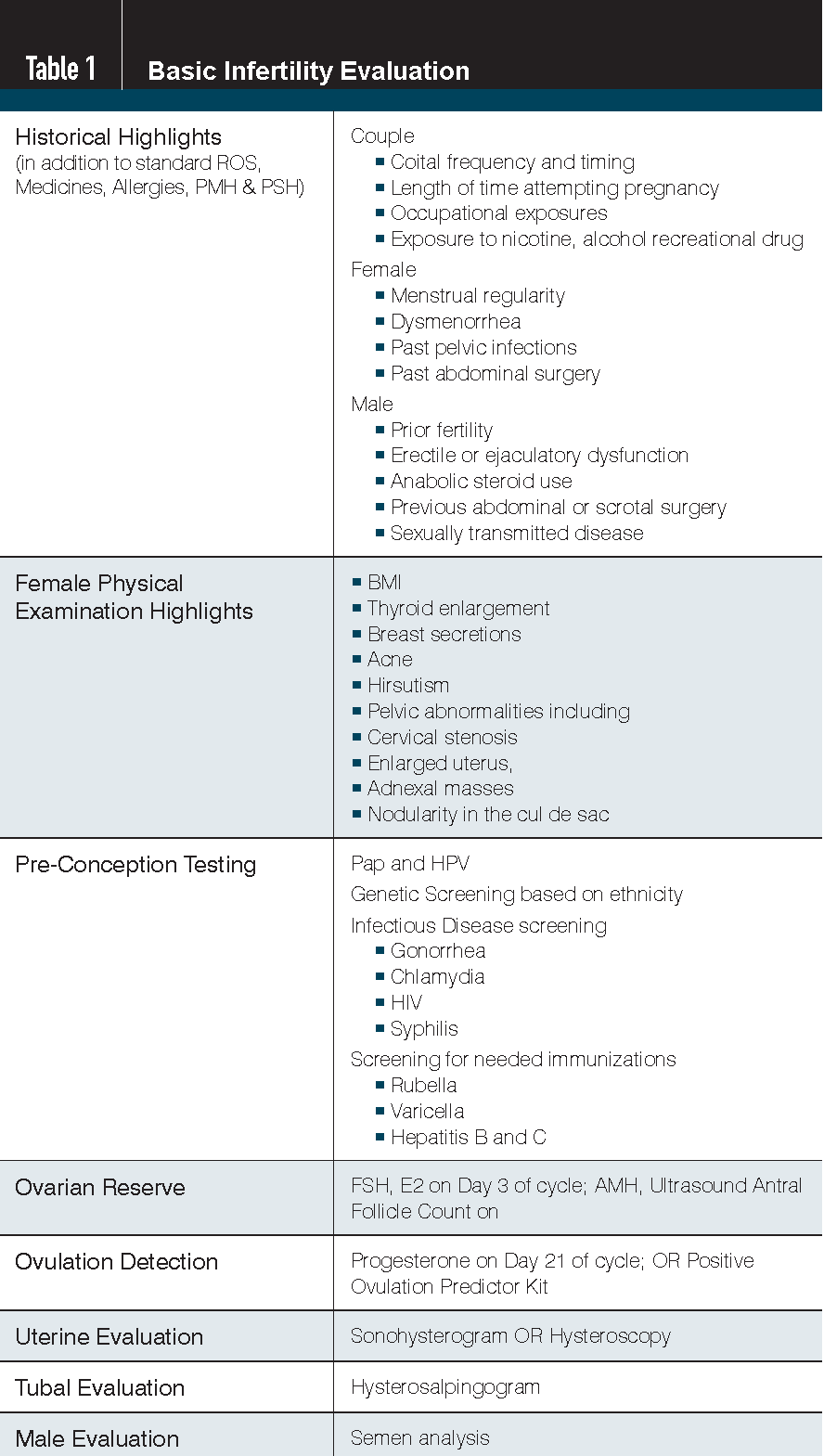
Endometriosis is a complex condition characterized by the presence of endometrial tissue in sites outside the uterine cavity. Endometriosis frequently presents with pain and affects 25-40% of women with infertility.10 Posited mechanisms for the relationship between endometriosis and infertility include distortion of pelvic anatomy, tubal obstruction, impaired oocyte quality, release and pickup, and altered endometrial receptivity, although a definite cause-effect relationship between any of these pathologies and endometriosis-related infertility is controversial.
While excisional surgery has been shown to improve spontaneous pregnancy rates in women with endometriosis11, surgery is not recommended for the routine evaluation of infertility in women without other symptoms of endometriosis.12
UTERINE FACTOR
Endometrial polyps, intracavity leiomyomas, intrauterine synechiae and Mullerian anomalies with associated distortion of the endometrial cavity may be associated with infertility.
Superior to the HSG in detecting uterine anomalies, sonohysterography detects intrauterine polyps or leiomyomas with a sensitivity and specificity of 91% and 84%, respectively.13 Direct visualization via hysteroscopy may be used to confirm the diagnosis (Figure 1). Treatment to remove the distorting mass is surgical.
CERVICAL FACTOR
The cervix is the entry to the upper reproductive tract. Its alkaline mucus protects sperm from the acidity of the vagina and guides sperm into the upper reproductive tract.
Structural alterations of the cervix, either congenital or post-surgical (for example, after loop electrosurgical excision procedure (LEEP) or large cervical cone biopsy) can cause cervical stenosis and prevent sperm entry.14
Post-operative stenosis is diagnosed by the failure to pass a 1 mm probe into the uterine cavity. The post-coital test, performed after intercourse to assess the viability of sperm in mucus, has been used to evaluate cervical function; however, the limited predictive value of this test has relegated it to history (Table 2).
In the absence of mucus and in the presence of cervical stenosis, intrauterine insemination is a successful therapy, assuming all other factors are normal.
Table 2: Tests no longer needed in the routine initial infertility evaluation
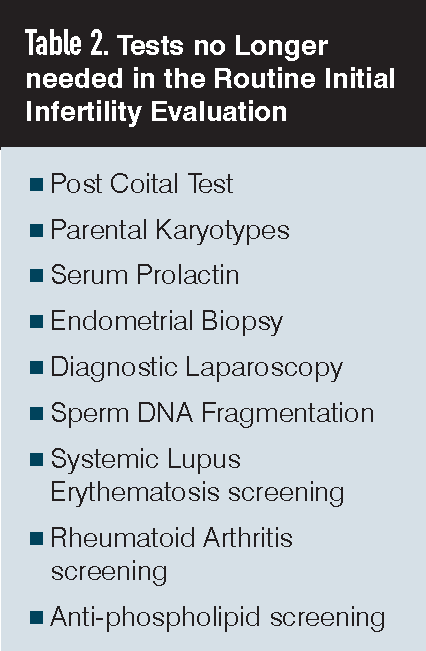
OVULATORY DYSFUNCTION AND ANOVULATION
Failure to ovulate results from a variety of non-reproductive influences including thyroid disease, pituitary disease, elevated androgens from adrenal hyperplasia, obesity, and stress. Anovulation is diagnosed by a mid-luteal serum progesterone concentration <3 ng/ml, although mid-luteal serum progesterone levels are usually higher than 7 ng/mL,15 and should be suspected when cycles are irregular and occur more often than every 21 days and less often than every 36 days.
The most common cause of anovulation is a metabolic disease, polycystic ovarian syndrome (PCOS) in which multiple follicles exist in various stages of development and are simultaneously a result of and caused by an altered hormonal milieu including insulin resistance, elevated LH, and elevated androgens.16
Women who do not ovulate do not produce progesterone and thus are at risk for the consequences of unopposed estrogen:endometrial hyperplasia and cancer.
Similarly, women with PCOS may experience non-reproductive disorders, particularly, acne, hirsutism and hyperinsulinemia. The metabolic consequences of PCOS increase a woman’s risk of diabetes mellitus, hyperlipidemia, gestational hypertension and gestational diabetes.
Correcting thyroid deficiency, lowering elevated prolactin, blocking elevated adrenal androgen production often stimulates ovulation. Weight loss of 15% of body weight often prompts ovulation to resume.17
Infertility associated with anovulation is best treated with ovulation induction unless other factors such as diminished ovarian reserve and male factors are present.
OVARIAN AGING (DIMINISHED OVARIAN RESERVE)
Female fecundity (the ability to conceive and carry a pregnancy to term) declines with increasing age, decreasing more rapidly after age 35,18,19 reflecting, in part, the progressive loss of oocytes (the “ovarian reserve”) that occurs with age. Aging oocytes also accumulate meiotic defects and DNA damage, causing deterioration of gamete quality and increasing the risk of aneuploid embryos and miscarriage.20,21
Therefore, women over 35 who have failed to conceive for six months should be offered expedited evaluation and treatment; for women over 40, immediate evaluation is warranted.19
Ovarian reserve refers to the number of oocytes available for stimulation and ovulation. It can be evaluated using serum FSH and estradiol concentrations on days 3-5 of a menstrual cycle, serum anti-Müllerian hormone (AMH), and/or ultrasound imaging of the ovaries for antral follicle count and ovarian volume determination (Table 3).22-26
Table 3: Tests to Assess Ovarian Reserve
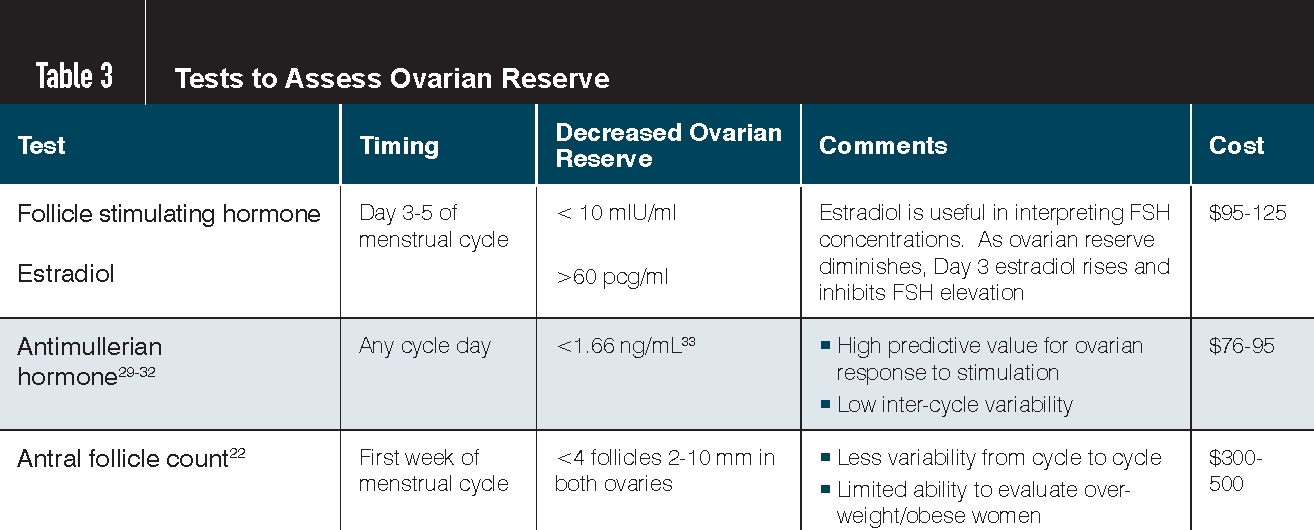
Notably, these tests may be predictive of response to exogenous ovarian stimulation and are not predictive of live birth or even natural fertility. Accelerated oocyte loss can result in loss of fertility and early menopause (prior to age 40).
While the majority of these cases are idiopathic,27 ovarian reserve should be monitored in women with a history of prior ovarian surgery, chemotherapy, radiation therapy, or with a family history of premature menopause. These women may be at risk for carrying the fragile X (FMR1) pre-mutation and also the consequences of estrogen deprivation.
MALE FACTOR
Disorders of male physiology occur in 35% of infertile couples and are the sole factor in 17% of couples.28 Similar to the female, in the male, FSH and LH stimulate the testes to produce testosterone and develop the immature gametes. Unlike the oocytes, sperm mature for three months in the male reproductive tract before being ejaculated.
Hormonal dysfunction of the male may arise from all areas of male reproductive physiology. When testosterone is low but not absent, erectile dysfunction and decreased libido commonly accompany alter semen parameters29 resulting in infertility.
Testicular failure also results in azoospermia. In addition, the concomitant lack of testosterone results in decreased libido and erectile dysfunction. As testosterone concentrations drop in the male, risk for heart disease, hyperlipidemia, osteopenia, and muscular mass loss increases.
Testosterone failure is diagnosed by a low serum testosterone and elevated LH and FSH. Of course, correcting any hormonal abnormality and screening for related disorders should precede treatment.
Diagnosis of male factor infertility begins with a well collected, comprehensive semen analysis performed in a certified andrology laboratory (Table 4). The semen sample is best collected at the laboratory, but when it must be collected at home, it should be delivered to the laboratory at body temperature within 30 to 60 minutes after ejaculation.
Table 4: World Health Organization Lower Limits of Normal Semen Parameters*
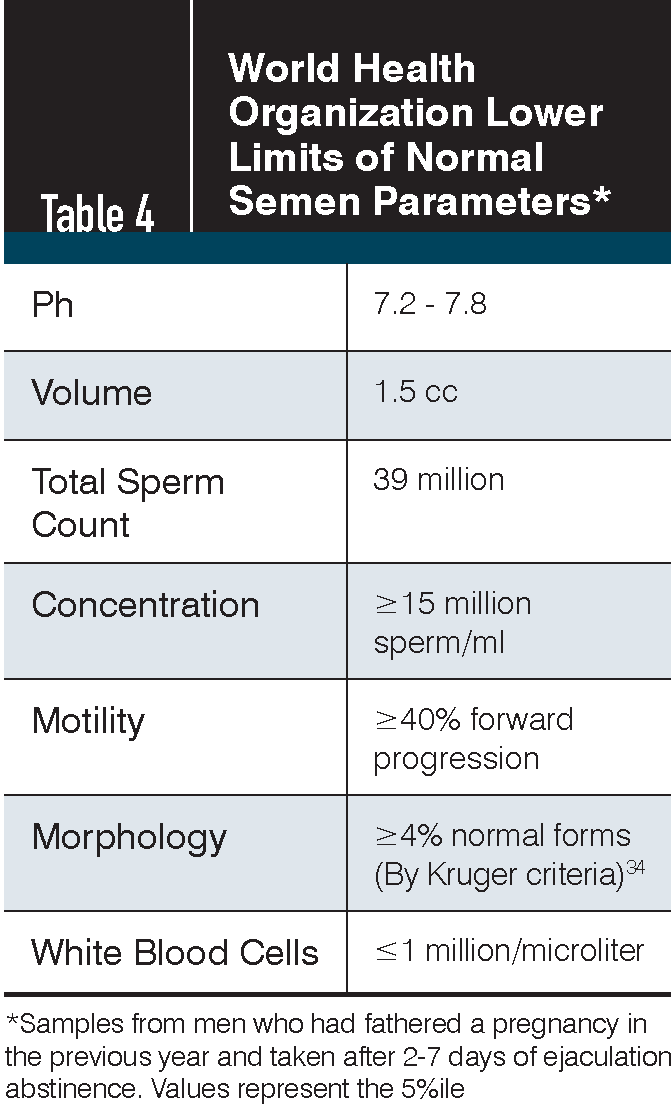
A diagnosis of an “abnormal” semen analysis should only be made after a confirmatory semen analysis has been performed, and must be interpreted in the context of the couple’s overall fertility evaluation. Other tests of sperm function are available, but their practical diagnostic value is subject to interpretation and are clinically not as useful.
Azoospermia is the absence of sperm in the ejaculate, not necessarily indicating an absence of sperm in the upper reproductive tract or the testes.
When the vas is patent, retrograde ejaculation may be diagnosed by retrieving sperm from the urine after orgasm and may be washed and used for intrauterine insemination. If the vas is blocked, sperm may be aspirated from the epididymis (MESA) or surgically extracted from the testes (TESA) and used for intracytoplasmic sperm injection (ICSI) at IVF.
In cases of azoospermia in which the sperm must be retrieved from the testes, testing for a mutation in the DAZ (Deleted in Azoospermia) gene can be a useful predictor of testicular sperm presence, as presence of the DAZ-c mutation predicts an almost 0% likelihood of finding sperm in the testes.30These genes may also be passed on to offspring; affected male patients may opt to use a donor sperm to prevent this outcome.
Similarly, men with an absent vas deferens may have a mutated allele for cystic fibrosis or a 5-T variant and if sperm is aspirated from the epididymis or testes for use in IVF, the resultant child may inherit cystic fibrosis.31 Thus, screening for the mutations is recommended when an absent vas deferens is detected.
Oligozoopspermia, or less than 15 million sperm/ml, and may signal partial retrograde ejaculation, hormonal disturbance or genetic conditions. If the testosterone levels are normal or low and the LH and FSH are normal, an empirical treatment with clomiphene citrate for 6 to 12 months may increase the sperm count.32
Monitoring testosterone and the semen analysis after three months is recommended. Asthenozoospermia is diagnosed when motility is < 40%, while teratospermia refers to the presence of < 4% normally formed sperm.
Male factor infertility may be treated by intrauterine insemination, possibly combined with ovulation induction of the female (COH-IUI) as discussed below. However, success rates with ICSI at IVF far exceed those with COH-IUI, especially when the normal morphology is <4% or the count is < 2million sperm/cc.
__
About the Authors
Dr. Kallen

Dr. Kallen is an assistant professor of Obstetrics, Gynecology, and Reproductive Sciences in the Division of Reproductive Endocrinology and Infertility within the Department of Obstetrics, Gynecology, and Reproductive Sciences at Yale School of Medicine, Yale University.
Dr. Carson

Dr. Carson is a professor of Obstetrics, Gynecology, and Reproductive Sciences in the Division Chief, Division of Reproductive Endocrinology and Infertility within the Department of Obstetrics, Gynecology, and Reproductive Sciences at Yale School of Medicine, Yale University.
__
References
1. Guttmacher AF. Factors affecting normal expectancy of conception. J Am Med Assoc [Internet]. 1956 Jun 30;161(9):855–860. Available from: https://doi.org/10.1001/jama.1956.02970090081016
2. American Society for Reproductive Medicine: Diagnostic evaluation of the infertile female. Fertil Steril [Internet]. Elsevier Inc.; 2015;103(6):e44–e50. Available from: http://dx.doi.org/10.1016/j.fertnstert.2015.03.019
3. Audu BM, Massa AA, Bukar M, El-Nafaty AU, Sa’Ad ST. Prevalence of utero-tubal infertility. J Obstet Gynaecol (Lahore). 2009;29(4):326–328. PMID: 19835502
4. Broeze KA, Opmeer BC, Van geloven N, Coppus SFPJ, Collins JA, Den hartog JE, Van der Linden PJQ, Marianowski P, Ng EHY, Van der Steeg JW, Steures P, Strandell A, Van der Veen F, Mol BWJ. Are patient characteristics associated with the accuracy of hysterosalpingography in diagnosing tubal pathology? An individual patient data meta-analysis. Hum Reprod Update. 2011;17(3):293–300.
5. Swart P, Mol BWJ, Van der Veen F, Van Beurden M, Redekop WK, Bossuyt PMM. The accuracy of hysterosalpingography in the diagnosis of tubal pathology: A meta-analysis. Fertil Steril [Internet]. Elsevier Masson SAS; 1995;64(3):486–491. Available from: http://dx.doi.org/10.1016/S0015-0282(16)57781-4 PMID: 7641899
6. Kodaman P, Arici A, Seli E. Diagnosis and Management of Tubal Factor Infertility. Curr Opin Obstet Gynecol. 2004;16(3):221–229.
7. Practice Committee of the American Society for Reproductive Medicine. Role of tubal surgery in the era of assisted reproductive technology: A committee opinion. Fertil Steril [Internet]. Elsevier Inc.; 2015;103(6):e37–e43. Available from: http://dx.doi.org/10.1016/j.fertnstert.2015.03.032
8. Maheux-Lacroix S, Boutin A, Moore L, Bergeron ME, Bujold E, Laberge P, Lemyre M, Dodin S. Hysterosalpingosonography for diagnosing tubal occlusion in subfertile women: A systematic review with meta-analysis. Hum Reprod. 2014;29(5):953–963.
9. De Silva PM, Chu JJ, Gallos ID, Vidyasagar AT, Robinson L, Coomarasamy A. Fallopian tube catheterization in the treatment of proximal tubal obstruction: A systematic review and meta-analysis. Hum Reprod. 2017;32(4):836–852.
10. Ozkan S, Murk W, Arici A. Endometriosis and infertility: Epidemiology and evidence-based treatments. Ann N Y Acad Sci. 2008;1127:92–100.
11. Brown J, Farquhar C. Endometriosis: An overview of Cochrane Reviews. Cochrane Database Syst Rev. 2014;2014(3). PMID: 24610050
12. American Society for Reproductive Medicine Practice Committee: Endometriosis and infertility. Fertil Steril [Internet]. American Society for Reproductive Medicine; 2012;98(3):591–598. Available from: http://dx.doi.org/10.1016/j.fertnstert.2012.05.031
13. Bittencourt CA, dos Santos Simões R, Bernardo WM, Fuchs LFP, Soares Júnior JM, Pastore AR, Baracat EC. Accuracy of saline contrast sonohysterography in detection of endometrial polyps and submucosal leiomyomas in women of reproductive age with abnormal uterine bleeding: systematic review and meta-analysis. Ultrasound Obstet Gynecol. 2017;50(1):32–39.
14. Boss EA, Van Golde RJT, Beerendonk CCM, Massuger LFAG. Pregnancy after radical trachelectomy: A real option? Gynecol Oncol. 2005.
15. Carmina E, Stanczyk F, Lobo R. Laboratory Assessment. In: Strauss J, Barbieri R, editors. Yen Jaffe’s Reprod Endocrinol Physiol Pathophysiol Clin Manag. Eighth. Elsevier; 2019. p. 887–915.
16. Sirmans SM, Pate KA. Epidemiology, diagnosis, and management of polycystic ovary syndrome. Clin Epidemiol. 2013; PMID: 24379699
17. Clark AM, Ledger W, Galletly C, Tomlinson L, Blaney F, Wang X, Norman RJ. Weight loss results in significant improvement in pregnancy and ovulation rates in anovulatory obese women. Hum Reprod. 1995;10(10):2705–2712. PMID: 8567797
18. Laing LM. Declining Fertility in a Religious Isolate: The Hutterite Population of Alberta, Canada. Hum Biol. 1980;52(2):289–310.
19. American Society for Reproductive Medicine: Female age-related fertility decline. Fertil Steril [Internet]. American Society for Reproductive Medicine; 2014;101(3):633–634. Available from: http://dx.doi.org/10.1016/j.fertnstert.2013.12.032
20. Jones KT. Meiosis in oocytes: Predisposition to aneuploidy and its increased incidence with age. Hum Reprod Update. 2008;14(2):143–158. PMID: 18084010
21. Oktay K, Turan V, Titus S, Stobezki R, Liu L. BRCA Mutations, DNA Repair Deficiency, and Ovarian Aging. Biol Reprod. 2015;93(3):1–10. PMID: 26224004
22. Tal R, Seifer DB. Ovarian reserve testing : a user ’ s guide. Am J Obstet Gynecol [Internet]. Elsevier Inc.; 2017;217(2):129–140. Available from: http://dx.doi.org/10.1016/j.ajog.2017.02.027
23. Steiner AZ, Pritchard D, Stanczyk FZ, Kesner JS, Meadows JW, Herring AH, Baird DD. Association Between Biomarkers of Ovarian Reserve and Infertility Among Older Women of Reproductive Age. Jama. 2017;318(14):1367–1376. PMID: 29049585
24. Hawkins Bressler L, Steiner A. Anti-Müllerian hormone as a predictor of reproductive potential. Curr Opin Endocrinol Diabetes Obes. 2018;25(6):385–390.
25. Pfeifer S, Butts S, Dumesic D, Fossum G, Giudice L, Gracia C, La Barbera A, Odem R, Pisarska M, Rebar R, Richard R, Rosen M, Sandlow J, Vernon M, Widra E. Testing and interpreting measures of ovarian reserve: A committee opinion. Fertil Steril [Internet]. American Society for Reproductive Medicine; 2015;103(3):e9–e17. Available from: http://dx.doi.org/10.1016/j.fertnstert.2014.12.093
26. ACOG Committee Opinion No. 773: The Use of Antimüllerian Hormone in Women Not Seeking Fertility Care. Obstet Gynecol. 2019;133(4):e274–e278.
27. Bachelot A, Rouxel A, Massin N, Dulon J, Courtillot C, Matuchansky C, Badachi Y, Fortin A, Paniel B, Lecuru F, Lefrere-Belda MA, Constancis E, Thibault E, Meduri G, Guiochon-Mantel A, Misrahi M, Kuttenn F, Touraine P. Phenotyping and genetic studies of 357 consecutive patients presenting with premature ovarian failure. Eur J Endocrinol. 2009;161(1):179–187.
28. Odisho AY, Nangia AK, Katz PP, Smith JF. Temporal and geospatial trends in male factor infertility with assisted reproductive technology in the United States from 1999-2010. Fertil Steril. 2014;
29. Nikoobakht MR, Aloosh M, Nikoobakht N, Mehrsay A, Biniaz F, Karjalian MA. The role of hypothyroidism in male infertility and erectile dysfunction. Urol J. 2012; PMID: 22395839
30. Ferlin A, Tessari A, Ganz F, Marchina E, Barlati S, Garolla A, Engl B, Foresta C. Association or partial AZFc region deletions with spermatogenic impairment and male infertility. J Med Genet. 2005;
31. Chillón M, Casals T, Mercier B, Bassas L, Lissens W, Silber S, Romey MC, Ruiz-Romero J, Verlingue C, Claustres M, Nunes V, Férec C, Estivill X, Estivill X. Mutations in the cystic fibrosis gene in patients with congenital absence of the vas deferens. N Engl J Med. 1995;
32. Willets AE, Corbo JM, Brown JN. Clomiphene for the treatment of male infertility. Reproductive Sciences. 2013.
33. La Marca A, Sighinolfi G, Radi D, Argento C, Baraldi E, Artenisio AC, Stabile G, Volpe A. Anti-Müllerian hormone (AMH) as a predictive marker in assisted reproductive technology (ART). Hum Reprod Update. 2009;16(2):113–130.
34. Kruger TF, Acosta AA, Simmons KF, Swanson RJ, Matta JF, Oehninger S. Predictive value of abnormal sperm morphology in in vitro fertilization. Fertil Steril. 1988; PMID: 3335257
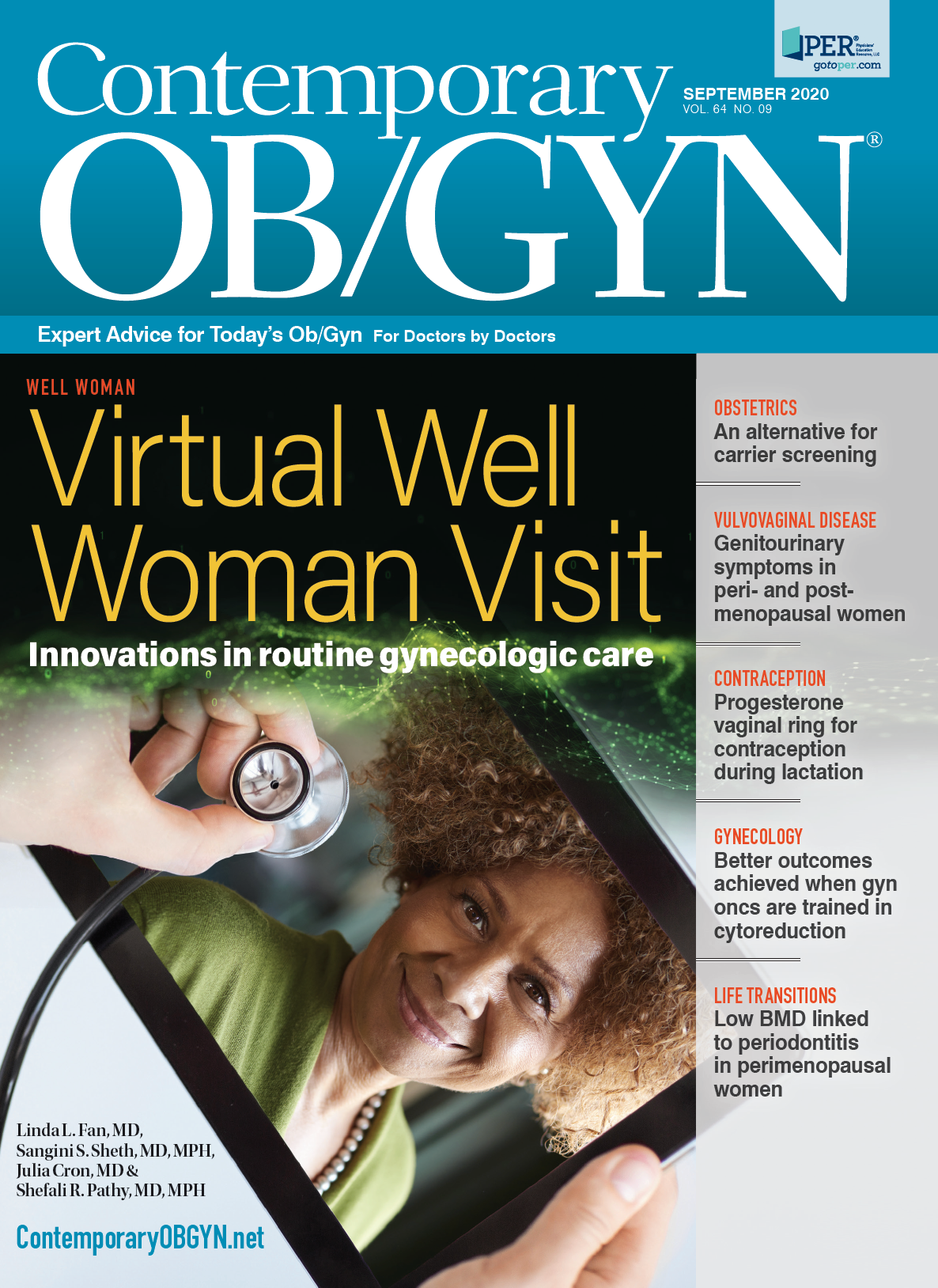
Study reports reduced maternal breastfeeding in late preterm infants
March 12th 2025A recent study reveals significantly lower initiation and continuation rates of Mother’s own milk feeding among late preterm infants compared to other gestational age groups, highlighting a need for targeted support.
Read More
In this episode of Pap Talk, Gloria Bachmann, MD, MSc, breaks down what it means to be a health care provider for incarcerated individuals, and explores the specific challenges women and their providers face during and after incarceration. Joined by sexual health expert Michael Krychman, MD, Bachmann also discusses trauma-informed care and how providers can get informed.
Listen
S4E1: New RNA platform can predict pregnancy complications
February 11th 2022In this episode of Pap Talk, Contemporary OB/GYN® sat down with Maneesh Jain, CEO of Mirvie, and Michal Elovitz, MD, chief medical advisor at Mirvie, a new RNA platform that is able to predict pregnancy complications by revealing the biology of each pregnancy. They discussed recently published data regarding the platform's ability to predict preeclampsia and preterm birth.
Listen
